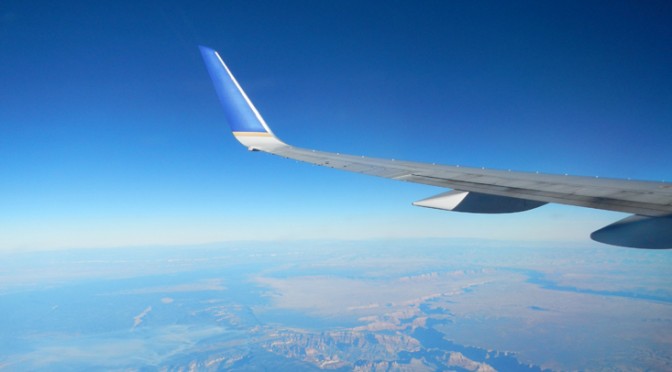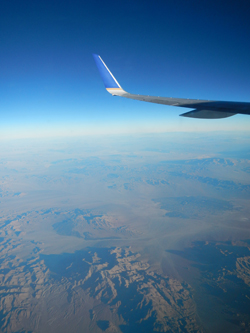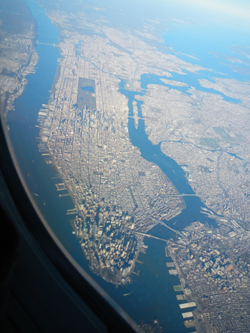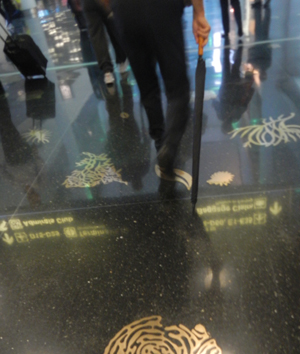Flying First Class or Business Class and having lounge privileges and priority boarding status are all obvious ways to make travel more luxurious. These days, however, more and more flights are running full, and seat upgrades are not available, even if you have the funds or frequent flyer miles. All the great airport lounges and the horizontal in-flight beds sometimes don’t seem like enough of a balance against shuffling through security and zooming through time zones in a pressurized cabin.
Below are some suggestions gathered from experience and seasoned travelers. Please add your own tips in the comments box below, so we can all fly more luxuriously, whatever the circumstances.
Before You Leave For the Airport
*Dress comfy, loose fitting clothing
*Apply extra moisturizer on your skin to compensate for the dry cabin air on-board
*Don’t wear metal jewelry/watches, if you want to make security easier
*Wear shoes that slip on and off easily, too
*Some people wear clothing on-board designed to carry your carry-on items for you, so you can be more hands-free while traveling. You can now get Scottevest creations in Harrods London as well as online.
* Packing with carry-on only can be a way to avoid baggage delays or losses, but it also means more stuff to carry from terminal to terminal or gate to gate if you have multiple flights. Once your carry-on is in the overhead compartment, it’s harder to access in-flight. Whether you check bags or not, put everything you want within reach on the plane into a separate pre-packed bag you can pull out and stow under your seat.
* You can even keep your pre-packed carry-on package (see tips below) ready for any trip.
On-board Package Suggestions
*Your own first class “travelers kit,” with a sleep mask, sock-slippers, ear plugs, tooth brush, and comb in a ziplock or a container you saved from your last upgraded flight (This can help when you want to catch some sleep in other circumstances, too.)
*Headset with noise canceling features
*Neck-supporting pillow (with aromatherapy scents), if it helps you
*Personal water bottle (Take it empty through security and fill it up before boarding the plane, so that even when service is slow, you stay hydrated.)
*Reading material to leave on-board when done (for privacy, remember to cut off any address labels on the magazines)
*Glasses case, if needed
*Laptop and charger (and an extra battery in case you wind up in economy on a long flight) The computer is great for work or playing with photographs, games, music, movies, etc.
*Camera (Shots out the window can be amazing.)
* A little flashlight (good for reading without the overhead light and for emergencies)
*Your favorite food for a meal and snacks
* Needed medications (Pre-calculate when you may need to take them while flying.)
*Anti-germ brigade (anti-bacterial wipes, some kind of nutritional supplement to fight germs, etc.) Comes in handy if you want to wash your hands before the meal, but you don’t want to wait in the bathroom line.
* Your smart phone/cell phone, computer/electronic reader. Even if they are fully charged (and they should be), include your charging units, too. If you have multiple things to charge bring a compact unit with multiple outlets.
Note: Make sure your name and number/email address are on everything, in case they get lose or left somewhere.
In-flight:
Hydration is key to a healthy flight. Regardless of whether you are flying first class or economy, the pressurized cabin air is often equivalent to being at an altitude of 5,000- 8,000 feet, so the air you are in for hours is thinner and drier. Also, the dry outside air (that may be at 35,000 or 40,000 feet) may be mixed with the filtered cabin air and circulated in the cabin for fresher oxygen.
You can bring a nasal spray or try taking a paper napkin or tissue, getting it wet, and placing it over your nostrils for awhile to keep the nasal passages from drying out. Drinking lots of water not only helps you hydrate, it might motivate exercise – as in, trips to the bathroom.
Movement is important. While the plane seems to be defying gravity’s law, our bodies are not. When you sit for long periods on the plane, you can swell up, and bad circulation can cause problems. Check with you doctor to see if wearing compression socks is a good idea for you.
Walking the aisles every couple of hours is recommended and can be entertaining for people watching.
Rotating your ankles and stretching your arms while in your seat helps. Some airlines have specially designed exercises that are often in the seat back pocket or on one of the channels of the entertainment on the monitor
In the galley of the plane (and while waiting for a bathroom,) you can do stretches and bends. The flight attendant conversations can be some of the best entertainment of the whole flight.
Veteran Flyer Tips on Trips and Jet Lag:
Milbry Polk is an intrepid explorer who crossed the Egyptian desert on a camel, has rafted rivers, and hiked in the Arctic. She also founded Wings WorldQuest, celebrating and supporting women explorers. Between books, projects, children and writing for the Explorers Club magazine, she shares her personal list of tips for air travel:
Never drink (alcohol) on the airplane
Drink lots of water
Take a neck pillow
Sit far forward, in an emergency exit row – it’s worth the extra money on longer flights
Don¹t eat airplane food
Bring sushi rolls or other easy-to-pack food items
Don’t bother with the film unless you are bored- it is always cut and probably won’t play out uninterrupted.
Sleep
Do sudoku (to help you fall asleep)
Stick with one airline if possible to rack up miles and join that airlines club.
Jet Lag
Joe Farago, a former actor and TV host who now travels all over the US to help with Emergency Disaster Training, developed his own ‘walk-nap-full evening’ formula for maintaining his body-clock: “The first thing most people want to do after flying all night is check into their hotel and go to sleep. When my room wasn’t ready, I dropped the bags and did some outdoor sightseeing until early afternoon. About three, I went back to the hotel, took a two-hour nap and then went out for an extended dinner meeting.
“When I woke up the next morning, I felt great and had adapted perfectly with no jet lag for the rest of the trip. Not only had the time spent outside in the sunlight helped reset my internal clock but, by restricting my nap to just two hours and going out until almost midnight that night, I had forced myself into the local day/night rhythm.”
Steve Tight emailed from Hong Kong, where he’s the President, International Development, Caesars Entertainment. Previously, when he lived in California developing Disneyland in Hong Kong, he racked up almost two million miles on one carrier.
He shares from experience: “I still travel on business a lot, usually a country or two a week, but at least most of it’s within Asia, so I’m home most weekends. I’m still a big Tylenol PM fan. I find it less aggressive than sleeping pills, and it really works in allowing me a full night’s sleep, even when on the other side of the world.
“Maybe I’m in a perpetual state of jet lag but the more I travel, the less I feel the affects of the time difference.
“There’s nothing like the almost nausea-like feeling after a transpacific flight, but if I can stay up until 9pm on the day of arrival in the States from Asia, I’m usually OK. Also I suggest the usual things, like changing the watch and Blackberry to the arrival time zone before landing. I’m now starting to watch out for what I eat and drink. It’s harder finding time for exercise with a busy travel schedule, so I’ve cut back on enjoying the alcohol on the flight – which probably also helps with jetlag.”
****************
Your Recommendations
Have you found a favorite airline for luxurious travel? A group called Skytrax takes surveys and rates the airlines, with five stars as the best possible rating. Hundreds of carriers are listed alphabetically for international and domestic flying. http://www.worldairlineawards.com/main/about.htm
Who has the best lounges? Which are the best and worst airports “for passenger wear and tear”? What do you take onboard for comfort? What is your best flying tip?
If you have additional tips for the best travel, airlines, and airports, please add your insights below, or write to me at Lisa@LuxuryTravelMavens.com And please forward this to other travel mavens you know who may be able to add their expertise.
Let’s all help each other have better take-offs, landings and times in-between!
© Lisa TE Sonne, excerpted for LuxuryTravelMavens.com
© All photographs by Lisa TE Sonne







Recent Comments